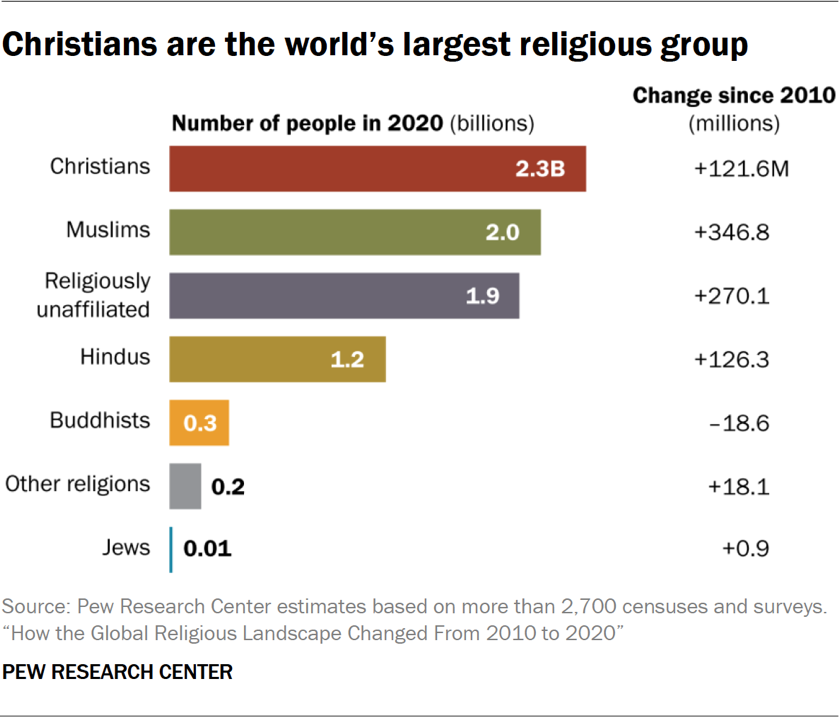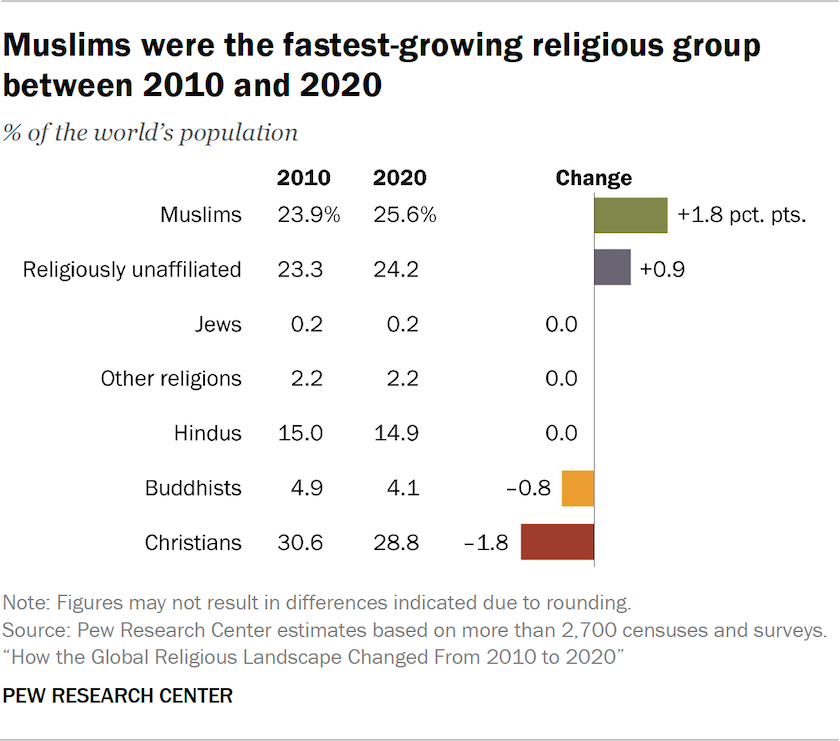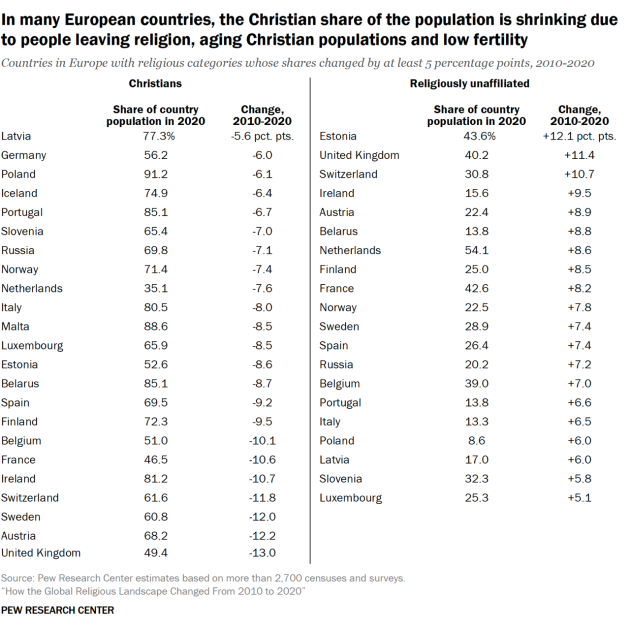A world with more Muslims and ‘nones’
A new Pew Research study focusing on the decade 2010-2020 shows how birth rates are key to the growth of Islam, while Christianity shifts its centre of gravity from the US and Europe to Africa.
13 JUNE 2025 · 16:06 CET

A study based on nearly 3,000 census and population surveys worldwide has mapped the evolution of the religious landscape in the decade from 2010 to 2020.
The renowned Pew Research Centre has analysed 201 countries to outline the religious landscape of the world to come.
The first finding is that Christianity remains the largest religion, with approximately 2.3 billion followers. But despite an increase of 122 million in the number of people who identify as Christian, the actual percentage is falling (from 30.6% to 28.5%), as it is growing at a slower rate than the world population.

Data and graphic: Pew Research Global Religious Landscape report, June 2025. The second conclusion is that Islam is the fastest-growing religion (from 23.9% in 2010 to 25.6% in 2020), although this increase is not due to adult conversions but to high fertility rates in predominantly Islamic areas.
“Muslims are having children at a greater rate than Muslims are dying. Very little of the change in Muslim population size is a result of people becoming Muslim as adults or leaving Islam as adults”, Conrad Hackett, one of the authors of the Pew study, told Religion News Service.
Secularisation in the decade 2010-2020
The third major finding of the study is that secularisation in the West continues to boost the number of people who say they have no religious affiliation (1.9 billion, up 270 million), to the point where it is now close behind the two main religions. The ‘non-religious’ are up from 23.3% to 24.2%.

The report highlights that “the growth of religious ‘nones’ is striking because they are at a ‘demographic disadvantage’ – their population is relatively old, on average, with relatively low fertility rates. However, unaffiliated people continued to grow as a share of the global population because many affiliated people around the world – primarily Christians – are ‘switching’ out of religion”.
Africa, the new centre of Christianity in the face of decline in Europe and North America
The data collected by Pew confirms with compelling figures that between 2010 and 2020, the centre of Christianity has shifted to the so-called Global South, particularly Africa.
Sub-Saharan Africa is now the area of the world with the most Christians. In 2010, 24.8% of the world's believers already lived there, but by 2020 that figure had shot up to 30.7%.

Europe, which in 2010 was still the most Christian region in the world (25.8%), has now fallen to third place, home to 22.3% of the world's believers in 2020.
It has also been overtaken by the Latin America-Caribbean region, which ranks as the second most Christian area, with 24.1%, despite stagnant growth.
Significant decline of Christianity in 40 countries
The other sorpasso is that of Asia-Pacific (remaining at 11.8%), which overtakes North America, which loses two points (from 12.4% to 10.5%).
There are up to 40 countries in the world where those who consider themselves Christian have fallen by 5% or more in the decade analysed. Among them are the United States, where the number of Christians has dropped by 14% and Australia, where it has fallen by 20%. The data show an almost direct correlation with the increase in those who now identify as ‘without religion’: up 13% in the United States and 17% in Australia.
“Over the same period, religiously unaffiliated people became a majority in the Netherlands (54%), Uruguay (52%) and New Zealand (51%), raising the number of places with an unaffiliated majority from seven to 10. These countries joined China, North Korea, the Czech Republic, Hong Kong, Vietnam, Macao and Japan, which already had religiously unaffiliated majorities in 2010”, says the new Pew report.
Religious changes in Europe
In 2020, Europe had 753 million inhabitants. Of these, “roughly two-thirds in 2020 were Christians, and a quarter were religiously unaffiliated. Around 6% of Europe’s residents were Muslims”.

Christianity remains the religion with which Europeans most identify, but it has fallen from 74.6% to 67.1% in 10 years.
The decline in Christians leads directly to an increase in ‘non-religious’ people, which rises from 18.7% to 25.3%. There are now 190 million in Europe, and in the Czech Republic they are already the largest group.
Despite the arrival of millions of asylum seekers from war zones in Europe during the decade analysed, Islam in Europe has not even increased by 1%. The case of greatest growth is Sweden, which went from 4% Muslims in 2010 to 8% in 2020.
In Germany, another country that welcomed refugees from Syria and other predominantly Muslim countries, the increase in Muslims was only 1% in this decade, reaching 7%.
Countries with the most Christians
In general terms, the United States remains the country with the most Christians in the world: 217 million (64% of the population), representing almost one in ten Christians worldwide (9.6%).
Another highly populated country, Brazil, is number two, with 168 million Christians (80.7% of the population) and 7.4% of the world's Christians.
They are followed by Mexico, the Philippines, Russia, Nigeria and Congo, leaving the first European country (Italy) in tenth place.
The absence of China in this ranking of Christian populations is striking, something that Pew explains as follows: “While media stories in the 2010s often suggested that China was on the cusp of having the largest Christian population in the world, surveys indicate that China's Christian population remains outside the 10 largest in the world”.
Join us to make EF sustainable
Learn all about our #TogetherInThisMission initiative here (English).
Published in: Evangelical Focus - world - A world with more Muslims and ‘nones’
